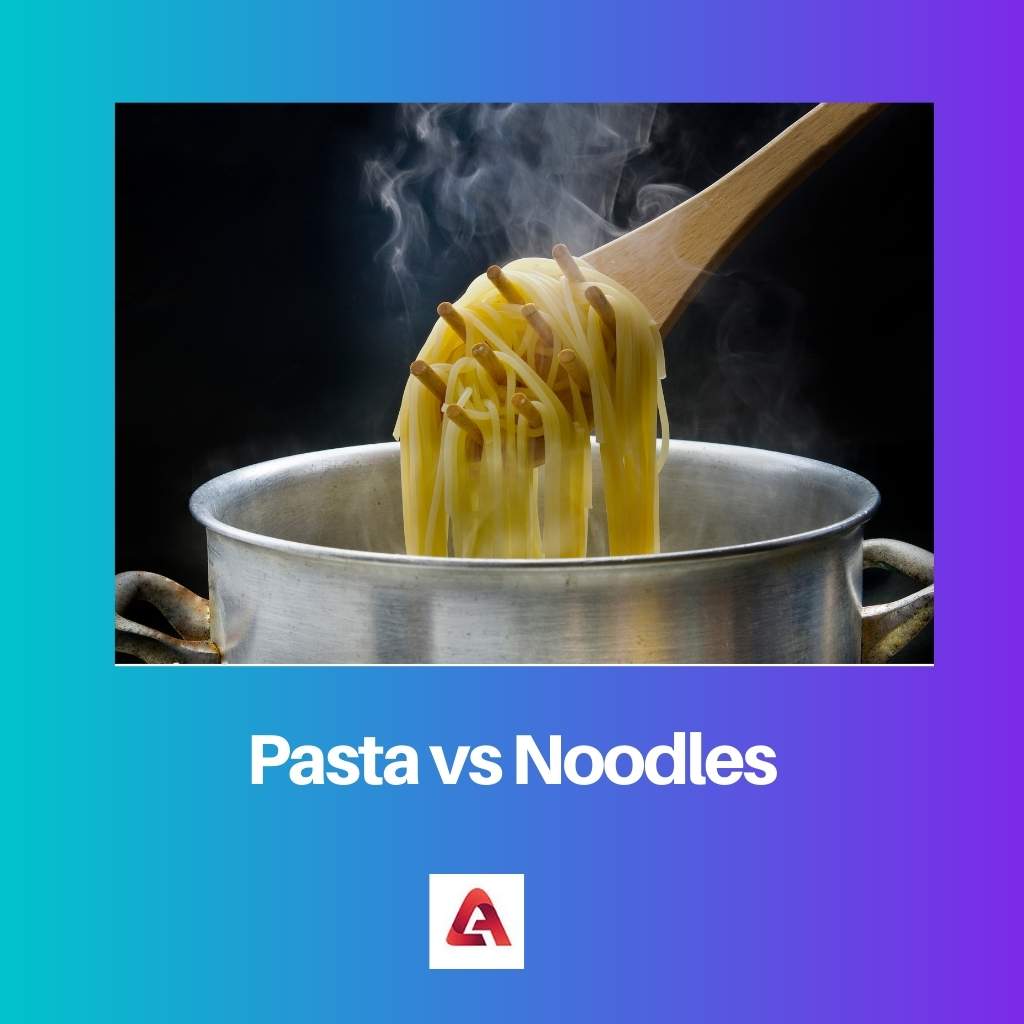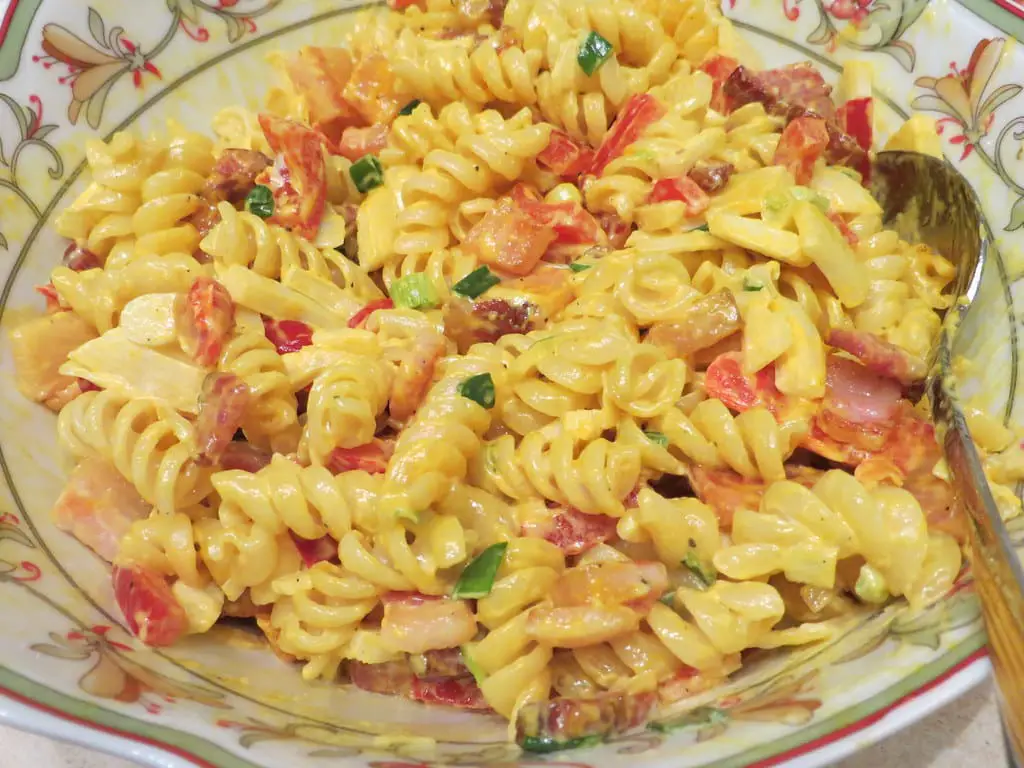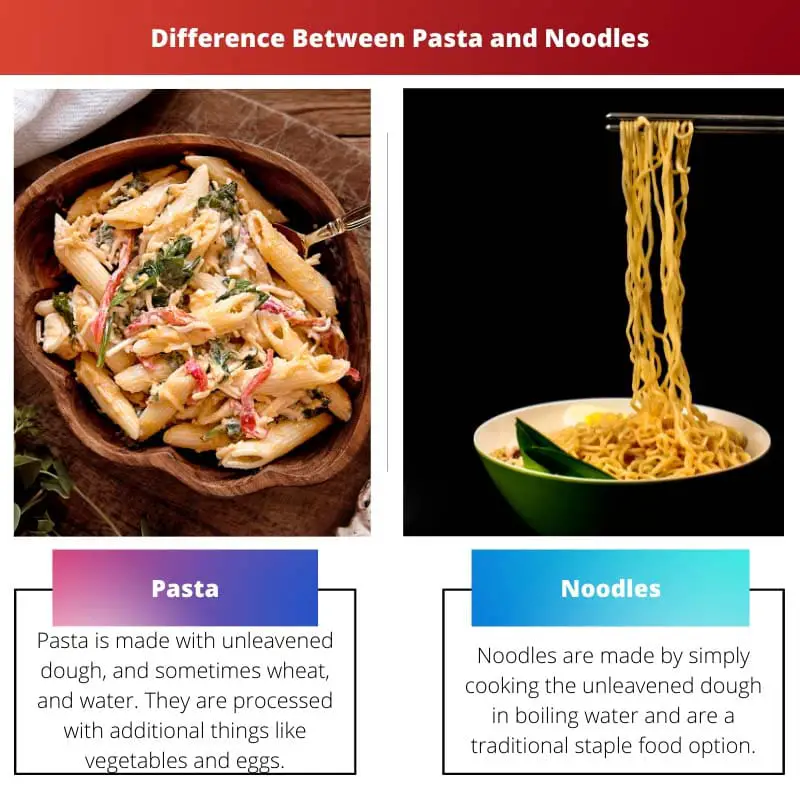Whenever we are out with our friends for a quick meal and chill, our hands go for the menu and end up ordering the most famous Pasta and Noodles.
Key Takeaways
- Pasta is an Italian dish made from wheat flour and water, whereas noodles can be made from various flours, including wheat, rice, and potatoes.
- Pasta shapes vary widely, while noodles are primarily long and thin.
- Pasta is associated with Italian cuisine, while noodles are found in many Asian dishes.
Pasta vs Noodles
Pasta is a food originating from Italy made of wheat flour, eggs and water that is formed into different shapes. Spaghetti, macaroni and fettucine are a few examples of pasta types. Noodles originate from China and are made from unleavened dough and formed into long strings or strips. It comes in a variety of options, such as ramen, basil noodles or udon.

Pasta is said to come in more than 350 different shapes across the world, which makes it a mystery bowl for a change. People used to knead the pasta by the foot before machinery came into use.
There are some common types of fresh raw noodles across various Asian countries, including Chinese white salt noodles, yellow alkaline noodles, and Japanese udon.
Comparison Table
| Parameters of Comparison | Pasta | Noodles |
|---|---|---|
| Definition | Pasta is made with unleavened dough, and sometimes wheat, and water. They are processed with additional things like vegetables and eggs. | Noodles are made by simply cooking the unleavened dough in boiling water and are a traditional staple food option. |
| Origin | The origin of pasta is Arabia. | The origin of noodles is the Tarim Basin of China and the Eastern Han Dynasty. |
| Ingredients | The ingredients used to make pasta are durum wheat. It also uses whole wheat and even eggs. | The ingredients used to make noodles are wheat and rice made with mung bean and sometimes potato. |
| Name Derivation | The term pasta is derived from the Latin pasta known as dough pastry or cake. In terms of Italian pasta and Greek pasta, it is known as barley porridge. | The term noodles are derived from German and Latin word as nodus, which means knot. |
| Fullness | Plump pasta is enough, but it looks expensive. | Noodles are also filling but come across as a cheap option. |
What is Pasta?
There is nothing new to say when one mentions that a healthy pasta meal comprises truly the sum of its parts. It features two key factors that circle around what you pair with your pasta, and of course, how much pasta you eat in a meal.
Pasta is worldwide famous, especially in Italy and America, as it has a certain versatility that allows for almost endless preparations.
There is more to the story. Pasta comes in many types with more than 350 shapes along with specific names. Some of the examples are spaghetti and macaroni.
| # | Preview | Product | |
|---|---|---|---|
| 1 |

| Jovial Brown Rice Fusilli - 12 Oz | Check Price on Amazon |
| 2 |

| Kaizen Low Carb Keto Pasta Fusilli - High Protein (20g), Gluten-Free, Keto-Friendly (6g Net),... | Check Price on Amazon |

What is Noodles?
Taking a pair of chopsticks to chop through the tasty swirling noodles is always an option without thought. Noodles, also known as cooked egg-and-flour paste that, are prominent and evident in European and Asian cuisines.
Moreover, noodles are commonly used to add body and flavour to broth soups. Hence, if you say you are in love with noodles, we would say we too.
A fun fact to realize about noodles is that in many cultures and regions, noodles are not just food, especially in Chinese traditions where noodles are the symbol of long life.

Main Differences Between Pasta and Noodles
- Pasta is an exclusive dish and hence comes across as an expensive one, whereas noodles are a traditional staple option, and so are cheaper.
- The term pasta is derived from the Latin pasta known as dough pastry, whereas noodles are derived from German and Latin words such as nodus, which means knot.

- https://www.sciencedirect.com/science/article/pii/S026087741300232X
- https://www.tandfonline.com/doi/abs/10.1080/10408398.2017.1367643



I found the descriptions of the different types of pasta and noodles to be really engaging. It made me want to learn more about this topic.
The article is full of interesting facts and is very eloquently written. I thoroughly enjoyed the comparison between the two foods.
In the 21st century, it is not correct to say that pasta is associated with Italian dishes. Pasta is a staple ingredient in diets across the globe. Not just Italy.
I agree, pasta is a very versatile ingredient and it is used in many cuisines around the world.
I can see where you are coming from, but there are certainly undeniable links between pasta and Italian cuisine. It’s a topic that could be debated for hours!
It is very informative and the two foods are compared really well. This article has made me hungry, though!
I couldn’t agree more. The descriptions of different pasta dishes have got me craving pasta for dinner tonight!
I was very interested to learn the difference between noodles and pasta. It’s something that I have never really considered before.
I’d like to know more about the origins of pasta and how it became such a popular food.
Me too, I think understanding the history of pasta and noodles would give a much greater appreciation for these foods.
This is a fascinating article. The section about the history of pasta and noodles was particularly intriguing.
I couldn’t agree with you more. I think the historical background of these foods is something that is overlooked.
It’s an interesting article, but I think it could be improved with more in-depth analysis of the cultural significance of pasta and noodles.
I completely understand what you’re saying. The cultural and historical aspects of these foods definitely deserve more attention.
This article has inspired me to try cooking more pasta and noodle dishes at home.